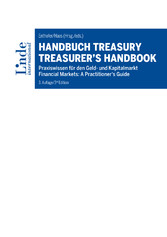Suchen und Finden
Service
Mehr zum Inhalt

Handbuch Treasury / Treasurer's Handbook - Praxiswissen für den Geld- und Kapitalmarkt / Financial Markets: A Practitioner's Guide
26Part I: The Money Market
The money market is the part of financial markets involving assets with original maturities of one year or shorter. Money market rates are determined by the liquidity situation of the market participants, on the central banks’ market policy and the individual maturity. The market is made up of central banks and credit institutions and to a smaller degree of institutional investors such as life insurers and public bodies. The money market provides liquidity funding for the global financial system. It allows acquiring necessary liquid funds as well as investing excess liquidity. In the international markets the market participants are funds, insurance companies, industrial and trading companies, which make extensive use of the liquidity transformation function of the markets.
Money market instruments being traded on the international money markets are interbank deposits, certificates of deposit, eligible bills, commercial papers und treasury bills.
The different money market instruments will be described in detail in chapter 2; chapter 1 introduces the basics of quotation and calculation of interest rates for money market instruments. Topics covered range from the typical types of yield curves and the corresponding theories through to methods for calculating interest rates, payment dates and conventions that are used for quoting interest rates.
Chapter 2 gives the reader an overview of the different money market instruments and then provides a precise description for each of these instruments including quotation and conventions of these money market instruments as well as comparisons between different instruments.
The third chapter deals with money market derivatives such as forward rate agreements and money market futures providing further information on conventions and terminology, the margin system and the application of money market futures. Furthermore, a comparison between those two derivatives is made.
Chapter 4 explains repurchase agreements (repos). You will get further information on quotation, terminology and the legal basics as well as the different types of repos, their application and risks.
28 The final chapter 5 explains a special interest rate swap, namely the overnight index swap and its functionality, conventions, terminology and application. The “normal” interest rate swaps and cross currency swaps are described in chapter 2 of part II.
Included in the following exams:
| • |
| • |
| • |
| • |
301. Methods of Interest Calculation, Yield Curve and Quotation
In this chapter you learn …
| • | which methods are used to determine the number of days for interest calculations. |
| • | which methods are used to determine the day basis for interest calculations. |
| • | which conventions are used in the money and capital markets. |
| • | what a yield curve is. |
| • | which three types of yield curves are distinguished. |
| • | which theories there are on the shape of a yield curve. |
| • | how to calculate interest rates for unusual terms using straight-line interpolation. |
| • | how interest rates are quoted. |
| • | what a basis point is. |
| • | when interest is paid for money market transactions with terms of up to one year or more, respectively. |
1.1. Methods of Interest Calculation
While calculating interests, the general question is how the interest for one period is determined. The interest calculation methods employed can vary, depending on national and product markets. As a rule, interest can be calculated in the following manner:
Alle Preise verstehen sich inklusive der gesetzlichen MwSt.








